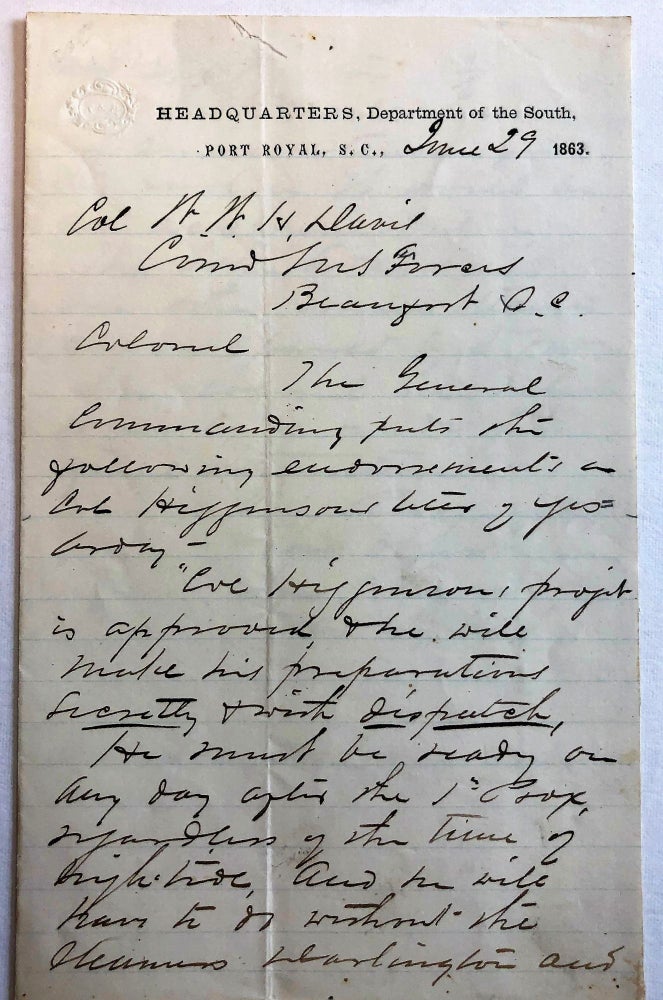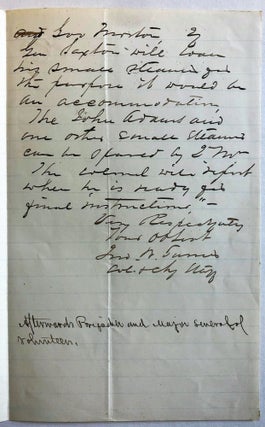HEADQUARTERS, DEPARTMENT OF THE SOUTH. PORT ROYAL, S.C., JUNE 29, 1863.
Port Royal: 1863. Manuscript letter, in ink, on printed letterhead of the Department of the South, from Colonel Jno. W. Turner advising Colonel W.W.H. Davis, commanding U.S. Forces at Beaufort, that Colonel Higginson's proposal has been approved: Higginson, with his First South Carolina Colored Troops, is to occupy James Island, Charleston Harbor. Folded octavo leaf, written on rectos only. One minor tape repair, Very Good.
"The General Commanding puts the following endorsement on Col. Higginson's letter of yesterday.
"Col. Higginson's project is approved, & he will make his preparations SECRETLY & with DISPATCH" [underlined in original].
"'He must be ready on any day after the 1st Prox, regardless of the time of high tide. And he will have to do without the steamers Darlington and Gov. Morton. If Gen Saxton will loan his small steamers for this purpose it would be an accommodation.
"'The John Adams and one other small steamer can be spared by ----. The colonel will report when his is ready for final instructions.'
"Very respectfully | Your ob. | Servt | Jno. W. Turner | Col. & Chf Staff."
Higginson's assault on James Island occurred during the first ten days of July, 1863. His 1st South Carolina Colored Troops was one of the earliest Union colored troops. Higginson was its first Commander.
As part of the "Operations Against the Defenses of Charleston," Union troops were to prepare for an attack upon Fort Wagner, Morris Island, a beachhead fortification that covered the southern approach to Charleston Harbor. The plan was to land on James Island, and then go by water to reduce a railroad bridge on the South Edisto River. Higginson led his 1st South Carolina Colored Infantry and some of the 1st Connecticut battery up to Willstown Bluff where his troops cleared a blockade and took possession of the area. They ran into trouble on their way to the rail bridge: the ship Enoch Dean was run aground twice; after intense shelling by the Washington Artillery of New Orleans and Chestnut and Marion batteries of South Carolina, Higginson's troops were forced to retreat. ["Civil War Raids & Skirmishes in 1863", website of American Civil War 101, accessed on Sept. 9, 2020.]
Higginson writes in his Memoirs: "Since a raid made by Colonel Montgomery up the Combahee, two months before, the vigilance of the Rebels had increased. But we had information that upon the South Edisto, or Pon-Pon River, the rice plantations were still being actively worked by a large number of negroes, in reliance on obstructions placed at the mouth of that narrow stream, where it joins the main river, some twenty miles from the coast. This point was known to be further protected by a battery of unknown strength, at Wiltown Bluff, a commanding and defensible situation. . . . Our proposition was to man the John Adams, an armed ferry-boat, which had before done us much service . . . to ascend in this to Wiltown Bluff, silence the battery, and clear a passage through the obstructions. Leaving the John Adams to protect this point, we could then ascend the smaller stream with two light-draft boats, and perhaps burn the bridge, which was ten miles higher, before the enemy could bring sufficient force to make our position at Wiltown Bluff untenable. The expedition was organized essentially upon this plan. The smaller boats were the Enoch Dean,-a river steamboat, which carried a ten-pound Parrott gun, and a small howitzer,-and a little mosquito of a tug, the Governor Milton . . . The John Adams carried, if I remember rightly, two Parrott guns (of twenty and ten pounds calibre) and a howitzer or two. The whole force of men did not exceed two hundred and fifty. We left Beaufort, S. C., on the afternoon of July 9th, 1863. . . . and fired our first shell into the camp at Wiltown Bluff at four o'clock in the morning. The battery- whether fixed or movable we knew not- met us with a promptness that proved very short-lived. After three shots it was silent. . ." [Higginson: ARMY LIFE IN A BLACK REGIMENT, 1869.]. Item #37066
Price: $1,500.00



